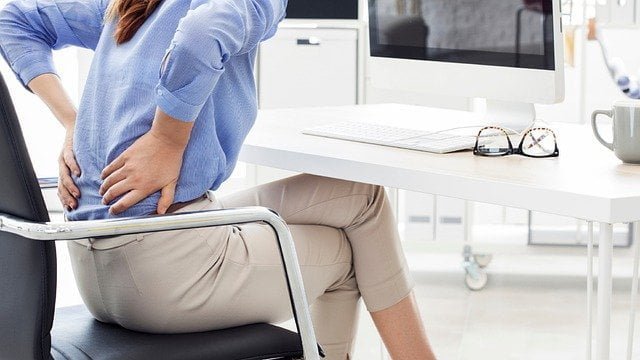Overview :

Overview :
Back pain is one of the most common reasons people go to the doctor or miss work, and it is a major cause of disability worldwide. Fortunately, you can take measures to prevent or relieve most back pain attacks. If prevention fails, simple home treatment and proper body mechanics will often heal your back within a few weeks and keep it functioning. Surgery is rarely necessary to treat back pain. To learn about back pain and ways to prevent it.
Symptoms :
Back pain can range from muscle aches to a burning or stabbing sensation. In addition, the pain may radiate down your leg or get worse with bending, twisting, lifting, standing, or walking.
When should you go to the doctor:
Most back pain gradually improves with home treatment and self-care, usually within a few weeks. You should go to the doctor if your back pain:
- It lasts for a few weeks
- Severe and does not improve with rest
- Spreads down one or both legs, especially if the pain extends below the knee
- It causes weakness, numbness, or tingling in one or both legs.
- accompanied by unexplained weight loss.
In rare cases, back pain can indicate a serious medical problem.
You must go to the hospital immediately if your back pain:
- It causes new problems in the intestines or bladder
- accompanied by fever
- Follows a fall, a blow to your back, or another injury.
Reasons :
Back pain often develops without a cause that can be determined by a doctor through an exam or imaging study. Conditions commonly associated with back pain include:
- Muscle or ligament strain. Repetitive weightlifting or sudden movement can strain the back muscles and spinal ligaments. If you are in poor physical condition, the constant pressure on your back can lead to painful muscle spasms.
- Bulging or ruptured discs. The discs between the vertebrae act as cushions between the bones (vertebrae) in the spine. The soft material inside the disc can herniate or rupture and put pressure on the nerve. However, you can have a bulging or ruptured disc without back pain. Disc disease is often discovered incidentally when a simple x-ray of the spine does not work for another reason.
- arthritis. Osteoarthritis can affect the lower back. In some cases, inflammation of the joints between the vertebrae in the spine can lead to narrowing of the canal around the spinal cord, a condition called spinal stenosis.
- Osteoporosis. Spinal vertebrae can suffer painful fractures if your bones become porous and brittle.
Risk factors :
Anyone can develop back pain, even children and teens. These factors may put you at greater risk of developing back pain:
- Omar. Back pain is more common as you age, starting at age 30 or 40.
- Lack of exercise. Back pain may be caused by weak and unused muscles in your back and abdomen.
- Overweight. Excess body weight puts extra pressure on your back.
- diseases. Some types of cancer and arthritis can contribute to back pain.
- Improper lifting. Using your back instead of your legs can lead to back pain.
- psychological conditions. People who are prone to depression and anxiety appear to be more likely to have back pain.
- smoking. Smokers have increased rates of back pain. This may happen because smoking causes more coughing, which can lead to a herniated disc. Smoking can also reduce blood flow to the spine and increase the risk of osteoporosis.
Prevention _
You may avoid back pain or prevent its recurrence by learning appropriate body mechanical practices and improving your physical condition.
To keep your back healthy and strong:
- Exercise: Regular, low-impact aerobic activities—those that don’t strain or rock your back—can increase strength and endurance in your back and allow your muscles to work better. Walking and swimming are good options. Talk to your doctor about activities you can try.
- Build muscle strength and flexibility: Abdominal and back exercises, which strengthen your core, help condition these muscles so that they work together like a natural corset for your back.
- Maintain a healthy weight: Being overweight strains the back muscles. If you are overweight, pruning can prevent back pain.
- Quit smoking: Smoking increases the risk of developing lower back pain. The risk increases with the number of cigarettes smoked per day, so stopping smoking should help reduce this risk.
Avoid movements that twist or strain your back. Use your body properly:
- Stand smart: don’t relax. Maintain a neutral pelvic position. If you must stand for long periods, place one foot on a low footrest to take the load off your lower back. alternate feet. Good posture can reduce the stress on the back muscles.
- Sit smart: Maintain good lower back support and armrests by choosing a suitable seat and swivel base. Placing a rolled up towel, pillow, or towel in the small part of your back can maintain a natural curve. Keep your knees and thighs level. Change your position frequently, at least every half hour.
- Lift smart: Avoid lifting heavy objects, if possible, but if you must lift something heavy, let your legs do the job. Keep your back straight – without making a twisting movement – and only bend at the knees. Hold the load and bring it close to your body. Look for a partner who lifts things with you if they are heavy.

Buyer awareness
Because back pain is so common, many products promise prevention or relief. But there is no conclusive evidence that special shoes, shoe accessories, back supports, specially designed furniture, or stress management programs can help.
Additionally, there does not appear to be one type of mattress that is best for people with back pain. It may have something to do with what feels most comfortable to you. We hope that we have provided the benefit of knowing everything related to spinal pain and ways to prevent it.



